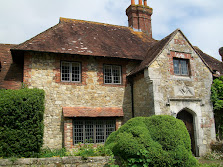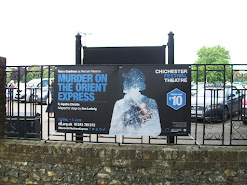As I have mentioned elsewhere in this blog, one of my favourite stories in the Canon is ‘The Sussex Vampire’, and in previous sojourns I have visited the two named addresses in the most bizarre letter ever sent, and Richmond Old Deer Park Rugby Ground where Robert ‘Big Bob’ Ferguson once threw Watson over the ropes. Having been referred to Holmes by Morrison, Morrison and Dodd, Ferguson sends a letter addressed from ‘Cheeseman’s, Lamberley’.
“Cheeseman’s, Lamberley. Where is Lamberley, Watson?”
“It is in Sussex, south of Horsham.”
“Not very far, eh? And Cheeseman’s?”
“I know that country, Holmes. It is full of old houses which are named after the men who built them centuries ago. You get Odley’s and Harvey’s and Carriton’s–the folk are forgotten but their names live in their houses”. [SUSS]
There is no Lamberley in Sussex, but the village of Amberley fits Watson’s description, as it is south of Horsham and can be reached from London Victoria where Watson indicates they caught their train. A Cheeseman family were also connected with the village, having moved from nearby Brighton. Therefore, travelling to Sussex on other business, I decided to make a brief detour.
Catching my train a few stops on from London Victoria at East Croydon, I travelled down to Barnham Station where I changed onto another train back a short way, arriving at Amberley Station. The railway arrived in Amberley in 1863, where at that time there was a thriving chalk pit where chalk was quarried and burnt in kilns to produce lime. A private siding was built to transport materials such as coal to the kilns, and the finished product of lime, away to market. The station buildings were original, dating back to 1863, and looked as they would have done when Holmes and Watson arrived from London.
It was then a mile walk along the South Downs Way to reach the village of Amberley itself, listening to Stephen Fry’s reading of the case. Entering the village, I reached ‘The Black Horse’ Public House. Unfortunately none of the pubs in the village were called ‘The Chequers’ where Watson indicates that they left their bags. (‘The Chequers’ is also the name of the public house in the previous story, ‘The Creeping Man’, hence Watson choosing to reuse it to disguise the identity of Lamberley).
Wandering around the village which was decorated to celebrate the Platinum Jubilee which was that weekend, I found myself poring over Watson’s description of ‘Cheeseman’s’, comparing with the many possible options.
“We drove through the Sussex clay of a long winding lane and finally reached the isolated and ancient farmhouse in which Ferguson dwelt. It was a large, straggling building, very old in the centre, very new at the wings with towering Tudor chimneys and a lichen-spotted, high-pitched roof of Horsham slabs. The doorsteps were worn into curves, and the ancient tiles which lined the porch were marked with the rebus of a cheese and a man after the original builder. Within, the ceilings were corrugated with heavy oaken beams, and the uneven floors sagged into sharp curves. An odour of age and decay pervaded the whole crumbling building”. [SUSS]
Having found two possibles, I finally decided on ‘Amberley House’, at the far end of the village close to the village church. None of the options that I found fitted Watson’s description perfectly, so I decided to make my way back to the station, taking a few general photos of the village as I did so.
Back at the station, I had a short wait for a train back to Barnham, from where I caught a train for a short hop to Chichester. Heading out of the station, I made my way up South Street until I reached The Cross, a stone monument, which indicated the intersection of four streets – North, South, East and West. Continuing up North Street, I finally reached a ring road, and took the pedestrian underpass to a car park. Walking through the car park, I reached my destination, Chichester Festival Theatre, where I was booked to see the penultimate performance of a dramatisation of Agatha Christie’s ‘Murder on the Orient Express’, by Ken Ludwig.
Having a few minutes to spare, I sat on the grass outside in the sunshine until it was time to go in. Purchasing a programme, I settled into my seat. Playing Poirot was Henry Goodman, who appeared as Prynne opposite John Malkovich’s Poirot in the BBC’s controversial 2018 dramatisation of ‘The ABC Murders’. Also in the cast were Patrick Robinson who played Doctor Watson in Liverpool Everyman’s 2018 production of ‘Baskerville’ (also by Ken Ludwig), Joanna McCallum who played Flora Miller in ‘The Eligible Bachelor’ opposite Jeremy Brett’s Holmes (and also appeared as Evie Howard in the David Suchet ‘The Mysterious Affair at Styles’) and Timothy Watson who played EW Hornung in the 2015 ITV dramatisation of ‘Arthur & George’ (but is best known for being Rob Titchener in ‘The Archers’). A couple of others had ‘Doctor Who’ credits – Laura Rogers (Isabella in ‘A Christmas Carol’) & Joanna Van Kampen (who has appeared in three Big Finish Spin-Off ranges).
The production was amazing with the front of an engine, snow effects and very effective moveable carriages, along with appropriate sound effects, meaning that the illusion of being on a train was well achieved. Goodman was excellent as Poirot, in particular in the final scenes where he was struggling with a moral dilemma. I also would want to mention Sara Stewart as the grating American, Helen Hubbard, who stole any scene that she was in.
Two-and-a-half hours later and I was stumbling out into the sun, and making my way back into the centre of Chichester to waste some time and get some dinner before seeing an evening performance at the nearby Minerva Theatre.
Just over two hours later and I was making my way into the theatre building for my second performance of the day – ‘The Unfriend’ – a new play written by ‘Sherlock’ co-creator, Steven Moffat, and directed by Mark Gatiss, the other co-creator and showrunner.
The main cast comprised a former ‘Sherlock’ regular Amanda Abbington (Mary), Mark Gatiss’ League of Gentleman cohort Reece Shearsmith, and Frances Barber (who as well as being Madame Kovarian in Moffat’s ‘Doctor Who: Series 6’, also appeared as the Matinee 'Madame Schirmer' in ‘Mr Holmes’). The cast also included Michael Simkins (whose memoir ‘What’s My Motivation’ is one of my favourites) as an unnamed neighbour, Gabriel Howell, Maddie Holliday and Marcus Onilude.
The programme indicated that the play was based on a true story told to Moffat by a friend, who had managed to extricate himself from the situation involved – finding out something shocking about someone whom you met briefly on a cruise and who is coming to stay with you. What followed was perfect British farce, again involving a grating American. (Click here for a fuller review).
Making my way back to Chichester Station, I arrived far too early for my train. However, eventually the train pulled in, and I made my way to East Croydon, having to change at Gatwick Airport. On my arrival at East Croydon at just gone midnight, I found that both of my planned ways home were not available given the time (the next X26 not being until 4.30am, and the trams to Wimbledon not running until a similar time). I therefore walked a short distance to catch a bus into Sutton, then another bus, and a fifteen minute walk to home. It had been a long and tiring day, and I fell asleep as soon as my head hit the pillow.











